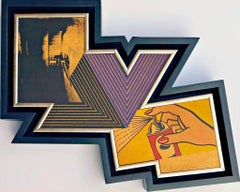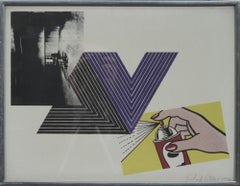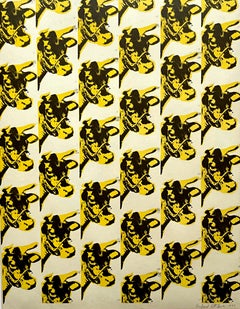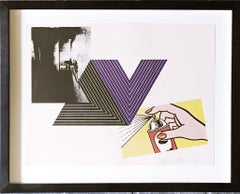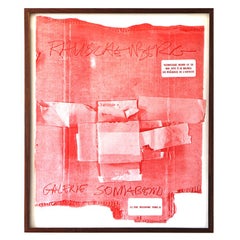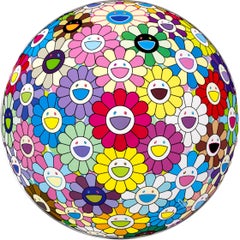Richard Pettibone Prints and Multiples
American, 1938-2024
Richard Pettibone was one of the pioneering artists to use appropriation techniques. Pettibone was born in Los Angeles, and first worked with shadow boxes and assemblages, illustrating his interest in craft, construction, and working in miniature scales.
(Biography provided by ArtWise)
to
1
2
1
1
Overall Width
to
Overall Height
to
4
5
1,171
919
894
818
4
4
3
1
1
1
4
2
1
1
2
4
Artist: Richard Pettibone
Richard Pettibone The Appropriation Warhol, Stella, Lichtenstein, Unique Signed
By Richard Pettibone
Located in New York, NY
Richard Pettibone
The Appropriation Print Andy Warhol, Frank Stella, Roy Lichtenstein, 1970
Silkscreen in colors on masonite board (unique variant on sculpted board)
Hand-signed by artist, Signed and dated on the front (see close up image)
Bespoke frame Included
This example of Pettibone's iconic Appropriation Print is silkscreened on masonite board rather than paper, giving it a different background hue, and enabling it work to be framed so uniquely.
The Appropriation print is one of the most coveted prints Pettibone ever created ; the regular edition is on a full sheet with white background; the present example was silkscreened on board, allowing it to be framed in 3-D. While we do not know how many examples of this graphic work Pettibone created, so far the present work is the only one example we have ever seen on the public market since 1970. (Other editions of The Appropriation Print have been printed on vellum, wove paper and pink and yellow paper.)
This 1970 homage to Andy Warhol, Frank Stella and Roy Lichtenstein exemplifies the type of artistic appropriation he was engaging in early on during the height of the Pop Art movement - long before more contemporary artists like Deborah Kass, Louise Lawler, etc. followed suit.
This silkscreen was in its original 1970 vintage period frame; a bespoke custom hand cut black wood outer frame was subsequently created especially to house the work, giving it a distinctive sculptural aesthetic.
Measurements:
Framed 14.5 inches vertical by 18 inches horizontal by 2 inches
Work
13 inches vertical by 16.5 inches horizontal
Richard Pettibone biography:
Richard Pettibone (American, b.1938) is one of the pioneering artists to use appropriation techniques. Pettibone was born in Los Angeles, and first worked with shadow boxes and assemblages, illustrating his interest in craft, construction, and working in miniature scales. In 1964, he created the first of his appropriated pieces, two tiny painted “replicas” of the iconic Campbell’s soup cans by Andy Warhol (American, 1928–1987). By 1965, he had created several “replicas” of paintings by American artists, such as Warhol, Roy Lichtenstein (1923–1997), Ed Ruscha (b.1937), and others, among them some of the biggest names in Pop Art. Pettibone chose to recreate the work of leading avant-garde artists whose careers were often centered on themes of replication themselves, further lending irony to his work. Pettibone also created both miniature and life-sized sculptural works, including an exact copy of Bicycle Wheel by Marcel Duchamp (French, 1887–1968), and in the 1980s, an entire series of sculptures of varying sizes replicating the most famous works of Constantin Brancusi (Romanian, 1876–1957). In more recent years, Pettibone has created paintings based on the covers of poetry books by Ezra Pound, as well as sculptures drawn from the grid compositions of Piet Mondrian (Dutch, 1872–1944). Pettibone straddles the lines of appropriation, Pop, and Conceptual Art, and has received critical attention for decades for the important questions his work raises about authorship, craftsmanship, and the original in art. His work has been exhibited at the Institute for Contemporary Art in Philadelphia, the Museum of Modern Art in New York, the Museum of Contemporary Art in Miami, and the Laguna Art Museum in Laguna Beach, CA. Pettibone is currently based in New York.
"I wished I had stuck with the idea of just painting the same
painting like the soup can and never painting another painting.
When someone wanted one, you would just do another one.
Does anybody do that now?"
Andy Warhol, 1981
Since the mid-1960s, Richard Pettibone has been making
hand-painted, small-scale copies of works by other artists — a
practice due to which he is best known as a precursor of appropriation art — and for a decade now, he has been revisiting subjects from across his career. In his latest exhibitions at
Castelli Gallery, Pettibone has been showing more of the “same”
paintings that had already been part of his 2005–6 museum retrospective,1
and also including “new” subject matter drawn from
his usual roster of European modernists and American postwar
artists. Art critic Kim Levin laid out some phases of the intricate spectrum from copies to repetitions in her review of the
Warhol-de Chirico showdown, a joint exhibition at the heyday
of appropriation art in the mid-1980s when Warhol’s appropriations of de Chirico’s work effectively revaluated “the grand
old auto-appropriator”.
Upon having counted well over a dozen
Disquieting Muses by de Chirico, Levin speculated: “Maybe he
kept doing them because no one got the point. Maybe he needed the money. Maybe he meant it when he said his technique
had improved, and traditional skills were what mattered.”
On
the other side, Warhol, in her eyes, was the “latter-day exemplar
of museless creativity”.
To Pettibone, traditional skills certainly
still matter, as he practices his contemporary version of museless creativity. He paints the same painting again and again,
no matter whether anybody shows an interest in it or not. His
work, of course, takes place well outside the historical framework of what Levin aptly referred to as the “modern/postmodern wrestling match”,
but neither was this exactly his match
to begin with.
Pettibone is one of appropriation art’s trailblazers, but his diverse
selection of sources removes from his work the critique of the
modernist myth of originality most commonly associated with
appropriation art in a narrow sense, as we see, for example, in
Sherrie Levine’s practice of re-photographing the work of Walker
Evans and Edward Weston. In particular, during his photorealist
phase of the 1970s, Pettibone’s sources ranged widely across
several art-historical periods. His appropriations of the 1980s
and 1990s spanned from Picasso etchings and Brancusi sculptures to Shaker furniture and even included Ezra Pound’s poetry.
Pettibone has professed outright admiration for his source artists, whose work he shrinks and tweaks to comic effect but, nevertheless, always treats with reverence and care. His response
to these artists is primarily on an aesthetic level, owing much
to the fact that his process relies on photographs. By the same
token, the aesthetic that attracts him is a graphic one that lends
itself to reproduction. Painstakingly copying other artists’ work by hand has been a way of making
it his own, yet each source is acknowledged in
his titles and, occasionally, in captions on white
margins that he leaves around the image as an
indication that the actual source is a photographic image. The enjoyment he receives in copying
is part of the motivation behind doing it, as is
the pleasure he receives from actually being with
the finished painting — a considerable private
dimension of his work. His copies are “handmade
readymades” that he meticulously paints in great quantities in his studio upstate in New York; the commitment
to manual labor and the time spent at material production has
become an increasingly important dimension of his recent work.
Pettibone operates at some remove from the contemporary art
scene, not only by staying put geographically, but also by refusing to recoup the simulated lack of originality through the
creation of a public persona.
In so doing, Pettibone takes a real
risk. He places himself in opposition to conceptualism, and he is
apprehensive of an understanding of art as the mere illustration
of an idea. His reading of Marcel Duchamp’s works as beautiful
is revealing about Pettibone’s priorities in this respect.
When
Pettibone, for aesthetic pleasure, paints Duchamp’s Poster for
the Third French Chess...
Category
1970s Pop Art Richard Pettibone Prints and Multiples
Materials
Masonite, Pencil, Screen
1970 'Appropriation print with Warhol, Lichtenstein
By Richard Pettibone
Located in Brooklyn, NY
This serigraph by Richard Pettibone, titled Appropriation, creatively unites iconic works by three of the most influential pop and minimalist artists: Andy Warhol, Frank Stella, and ...
Category
1970s Pop Art Richard Pettibone Prints and Multiples
Materials
Screen
$6,000 Sale Price
20% Off
Pettibone's Andy Warhol Cow Wallpaper, pencil signed famed appropriation print
By Richard Pettibone
Located in New York, NY
Richard Pettibone
Andy Warhol Cow Wallpaper
Silkscreen on paper
26 1/2 × 20 3/4 inches
Hand Signed and dated in graphite on the front
Unframed
More about R...
Category
1970s Pop Art Richard Pettibone Prints and Multiples
Materials
Screen
Pop Art Appropriation Print: Andy Warhol, Frank Stella, Roy Lichtenstein, SIGNED
By Richard Pettibone
Located in New York, NY
Richard Pettibone
The Appropriation Print: Andy Warhol, Frank Stella, Roy Lichtenstein, 1970
(Andy Warhol's Electric Chair, Frank Stella's Empress of India and Roy Lichtenstein's Spray)
Silkscreen in colors on smooth wove paper
Pencil signed and dated 1971 on the front
Frame included:
Elegantly floated and framed in a white wood frame under UV plexiglass in accordance with museum conservation standards
Measurements:
frame: 15 7/8 x 19 3/4 x 1 3/4 inches
sheet: 12 1/4 x 16 inches
This is one of Richard Pettibone's most iconic, popular and desirable prints done in 1970 - during the most influential era of the Pop Art movement. This homage to Andy Warhol, Frank Stella and Roy Lichtenstein exemplifies the type of artistic appropriation he was engaging in early on during the height of the Pop Art movement - long before more contemporary artists like Deborah Kass, Louise Lawler, etc. followed suit. Pencil signed and dated recto. It was created in limited edition - though the exact number is not known.
More about RIchard Pettibone:
As a young painter, Richard Pettibone began replicating on a miniature scale works by newly famous artists, and later also modernist masters, signing the original artist’s name as well as his own. His versions of Andy Warhol’s soup...
Category
1970s Pop Art Richard Pettibone Prints and Multiples
Materials
Screen, Pencil
Related Items
Cardbirds, 1972 exhibition, rare original red poster, Robert RAUSCHENBERG
By Robert Rauschenberg
Located in Brooklyn, NY
Robert RAUSCHENBERG
Cardbirds, 1972 exhibition, rare original poster
For the exhibition "Cardbirds" at the Sonnabend Gallery
Signed in the plate framed in walnut.
21 x26.5" framed.
...
Category
1970s Pop Art Richard Pettibone Prints and Multiples
Materials
Screen
$1,000 Sale Price
60% Off
H 26 in W 21 in
Flowerball: Colorful, Miracle, Sparkle - Pop Art Japanese Flowers Colours
By Takashi Murakami
Located in London, GB
Edition of 300. Murakami signed and numbered in silver marker pen along the lower right edge.
Offset lithograph with cold foil stamp and high gloss varnishing on UV paper—diameter si...
Category
2010s Pop Art Richard Pettibone Prints and Multiples
Materials
Offset
$4,796
H 27.96 in Dm 27.96 in
Keith Haring Tony Shafrazi gallery 1982 (set of 6 printed works)
By Keith Haring
Located in NEW YORK, NY
Keith Haring Tony Shafrazi 1982: set of 6 printed works:
A set of six, individual, double-sided lithographic inserts from the seminal, spiral bound 1982 Keith Haring Tony Shafrazi ca...
Category
1980s Pop Art Richard Pettibone Prints and Multiples
Materials
Lithograph, Offset
Keith Haring Tony Shafrazi gallery 1982 (set of 4 printed works)
By Keith Haring
Located in NEW YORK, NY
Keith Haring Tony Shafrazi 1982: set of 6 printed works:
A set of six, individual, double-sided lithographic inserts from the seminal, spiral bound 1982 Keith Haring Tony Shafrazi ca...
Category
1980s Pop Art Richard Pettibone Prints and Multiples
Materials
Lithograph, Offset
“The Missing Suitors” by SHAG aka Josh Agle
By Josh Agle
Located in Hudson, NY
The Missing Suitors is a limited edition 13 color hand-pulled Serigraph by artist Josh Agle aka SHAG. Hand signed and numbered 214/300 by the artist. Comes with a Certificate of authenticity (C.O.A.).
Shag is an American born painter, designer and illustrator working in Southern California. His distinctive artistic style draws from commercial illustration and has an attitude and sly sense of humor which is unmistakably of our time. His paintings celebrate consumerism and consumption on vividly colored sharply rendered panels; the characters drink, smoke and eat in lavish, stylish surroundings.
Shag's work is categorized as lowbrow art...
Category
Early 2000s Pop Art Richard Pettibone Prints and Multiples
Materials
Screen
$1,080 Sale Price
20% Off
H 29.5 in W 12 in D 0.03 in
Modern Print /// Roy Lichtenstein Pop Art Abstract Geometric MoMA Gemini G.E.L.
By Roy Lichtenstein
Located in Saint Augustine, FL
Artist: Roy Lichtenstein (American, 1923-1997)
Title: "Modern Print"
*Numbered, signed, and dated by Lichtenstein in pencil lower right
Year: 1971
Medium: Original Lithograph and Scr...
Category
1970s Pop Art Richard Pettibone Prints and Multiples
Materials
Lithograph, Screen
"Waco" Serigraph by Billy Schenck, 1981
By Billy Schenck
Located in Los Angeles, CA
Bill Schenck
Waco
Serigraph 7/58
1981
Hand signed, date and numbered by Schenck in pencil.
25.75 inches H. x 25 inches W.
'Waco' is classic early example...
Category
Late 20th Century Pop Art Richard Pettibone Prints and Multiples
Materials
Screen
“The Winter Ball” 1988
Located in Austin, TX
Poster Size: 23.5 x 16.5 in.
Vintage Gold Leaf Frame Size: 23.5 x 16.5 in.
Signed and inscribed in gold marker, bottom right
A poster for "The Winter Ball 1988" in Houston, Texas, p...
Category
1980s Pop Art Richard Pettibone Prints and Multiples
Materials
Paper, Lithograph, Offset
British Pop Art Artist RB Kitaj Screenprint Day Book Serigraph Silkscreen Signed
By Ronald Brooks Kitaj
Located in Surfside, FL
R.B. Kitaj (British American 1932-2007)
Hand signed and numbered
Screenprint
Measures approximately 24.5 X 16.65 inches
This is from the Robert Creeley daybook. They were done in ...
Category
1970s Pop Art Richard Pettibone Prints and Multiples
Materials
Screen
British Pop Art Artist RB Kitaj Screenprint Day Book Serigraph Silkscreen Signed
By Ronald Brooks Kitaj
Located in Surfside, FL
R.B. Kitaj (British American 1932-2007)
Hand signed and numbered
Screenprint
This is from the Robert Creeley daybook. They were done in a variety of mixed media including serigraph, ...
Category
1970s Pop Art Richard Pettibone Prints and Multiples
Materials
Screen
Kenny Scharf Tony Shafrazi gallery 1984 (Kenny Scharf 1984)
By Kenny Scharf
Located in NEW YORK, NY
Vintage 1984 Kenny Scharf Exhibition Poster:
Original Kenny Scharf illustrated exhibition poster published by Tony Shafrazi Gallery in conjunction with the Fun Gallery, New York, NY 1984. Fun, cool, vibrant original 1980s pop art without breaking the bank.
Medium: Offset Lithograph, 1984.
Dimensions: 23 x 24.75 inches (folded open).
Condition: Fold-lines as issued; good overall vintage condition.
Muralist, painter, sculptor, and installation artist Kenny Scharf (American, b. 1958) is best known for his fantastical, large-scale paintings of anthropomorphic animals...
Category
1980s Pop Art Richard Pettibone Prints and Multiples
Materials
Offset, Lithograph
$400 Sale Price
23% Off
H 24.75 in W 23 in
Hero as a Riddle by Eduardo Paolozzi gold silver pop art with Basquiat style
By Eduardo Paolozzi
Located in New York, NY
Hero as a Riddle (1963) depicts a smiling head printed in gold, silver, and black. The shapes and lines composing the figure’s face are architectural and geometric: the eyes are comp...
Category
1960s Pop Art Richard Pettibone Prints and Multiples
Materials
Screen
$2,650
H 39.5 in W 29.5 in
Richard Pettibone prints and multiples for sale on 1stDibs.
Find a wide variety of authentic Richard Pettibone prints and multiples available for sale on 1stDibs. You can also browse by medium to find art by Richard Pettibone in screen print, masonite, mixed media and more. Much of the original work by this artist or collective was created during the 1970s and is mostly associated with the Pop Art style. Not every interior allows for large Richard Pettibone prints and multiples, so small editions measuring 17 inches across are available. Customers who are interested in this artist might also find the work of Corita Kent, Oyvind Fahlstrom, and Bob Stanley. Richard Pettibone prints and multiples prices can differ depending upon medium, time period and other attributes. On 1stDibs, the price for these items starts at $5,000 and tops out at $15,000, while the average work can sell for $7,250.
